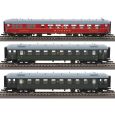Brawa 46185 passenger car B4ioü, ÖBB, Ep.III
Delivery time: 3 ‐ 10 business days (Germany)
Check availability in store:
- Store Oschatz: currently unavailable
Share with friends:
Brawa 46185 passenger car B4ioü, ÖBB, Ep.III Product Details
About the model: The ÖBB B4ipü express train car is a detailed model of the BRAWA brand. In addition to its prototypical appearance, the car has other impressive features, such as a multi-part interior and metal wheels. The model has also been prepared for retrofitting interior lighting. Furthermore, the car has a length of 239.8 mm and was given the road number "32 103".
About the prototype: In the mid-1920s, the DRG began to significantly upgrade the travel comfort of its express and passenger train connections. In addition to the newly procured two-axle cars, four-axle compartment cars were primarily used on the long-distance routes (there were, for example, accelerated passenger trains Munich - Berlin). From 1928, several four-axle through coaches with open gangways began to be tested, which were to be used on these services in the future. The test wagons proved their worth and from 1930 over 1,000 B-BC and C4i wagons of riveted construction were procured. A characteristic feature was that the B section always had single-leaf doors, while the C section had double doors. When the advances in welding technology could also be used for wagon construction, the tried and tested design had to be adapted. In 1935, three test wagons each of the BC and C designs were procured, which were followed by almost unchanged series production. Despite the weight saving, the welded coaches had fewer seats than their riveted predecessors, as the DRG designed the passenger compartments to be more spacious. There were also larger windows and their lower edge, which was positioned 150 mm lower, offered "Steppkes" in particular a better field of vision of the train operation, which was not yet dominated by noise barriers. In the welded version, over 1,000 C and 145 BC coaches were built in six years, before progress made further improvements possible in the form of the apron coaches. The war scattered the express train carriages across half of Europe, with larger stocks outside the German railroads being held by the ÖBB, SNCF and PKP, among others. At the DB and DR, the coaches remained indispensable in district traffic until the end of the 1970s and thus became over forty years old. Until the 1960s, they were also used internationally, from Scandinavia to the Balkans. There were numerous conversions, including sleeping, dining, buffet and half-luggage coaches. For the anniversary in 1985, DB refurbished a complete train consisting of several different types of express train carriages. Unfortunately, these carriages are now scattered across several locations and only a few of them are still operational.
Features:
- Gauge: H0
- Era: III
- road number: 32 103
- Length over buffers: 239.8 mm
- Close coupler kinematics
- Interior lighting can be retrofitted
- Metal axle bearing
- Metal wheels
- Scale windows
- Details typical of the era
- Multi-part brake system
- Finely engraved roof rivets
- Multi-part interior
- Prototypical frame structure
- Bogie with three-point bearing
- Detailed reproduction of the "Görlitz V" bogies
Specs:
- Gauge: H0
- Rail Company: ÖBB/BBÖ
- Era: III
- Color: Green
- News: 2023
- Type: Passenger wagon
Further links:
CAUTION: Not suitable for children under 3 years. Danger of swallowing! Age recommendation from 14 years.
Achtung! Maßstabs- und originalgetreue Kleinmodelle sowie Elektrozubehör für erwachsene Sammler. Nicht geeignet für Kinder unter 14 Jahren
Zum Betrieb des vorliegenden Produkts darf als Spannungsquelle nur ein nach VDE 0570-2-7/DIN EN 61558-2-7 gefertigter Spielzeug-Transformator verwendet werden.












